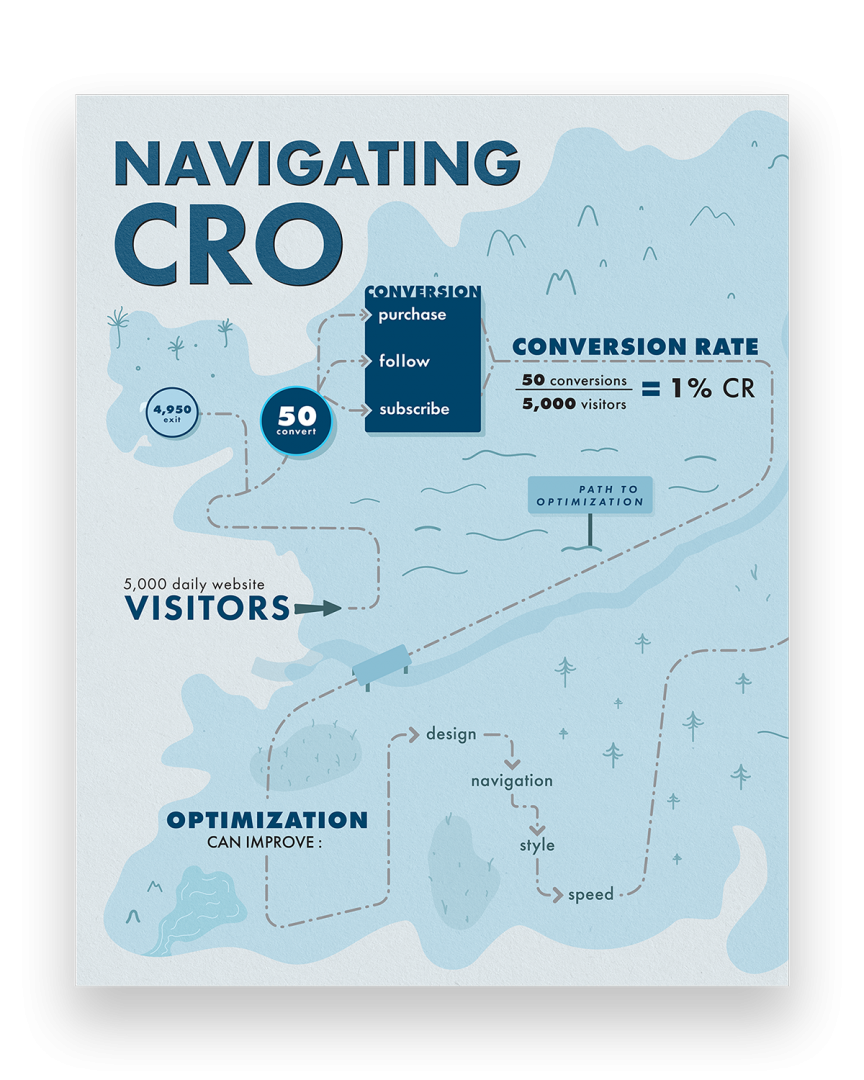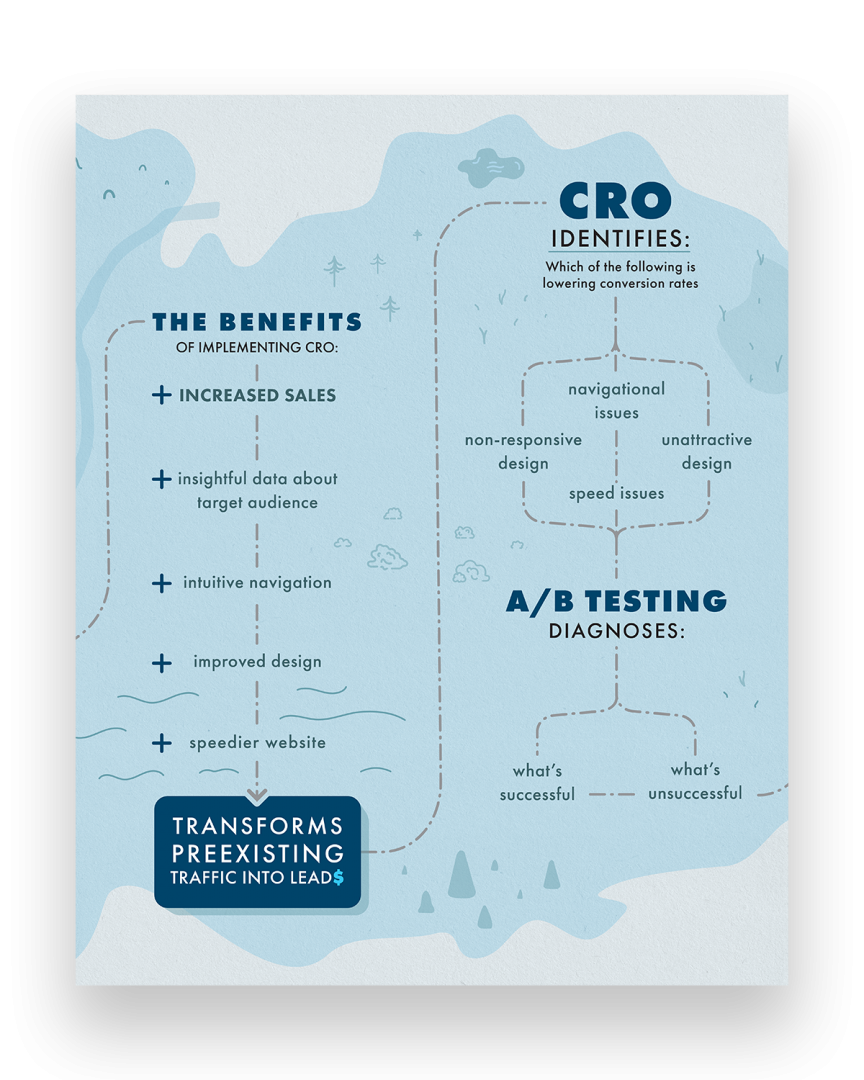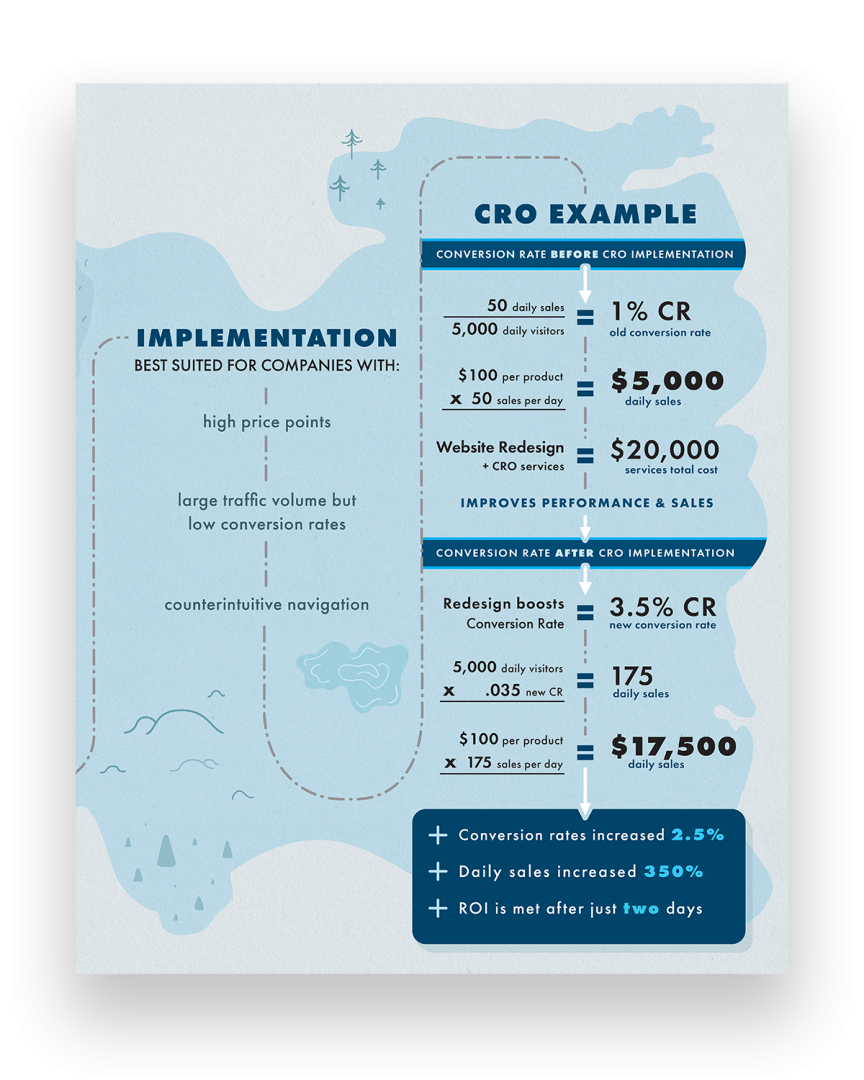We welcome another acronym with enormous potential–CRO. Conversion rate optimization can define the prosperity of a business, especially in e-commerce. Connect with us to learn more and begin your conversion rate optimization journey today!
The employment of strategic CRO by marketers, designers, or developers is necessary for maintaining relevance among competitors. One can begin contextualizing the importance of CRO by breaking the definition down, evaluating the benefits of implementation, and identifying who benefits. Navigating CRO doesn’t need to be a treacherous journey. Instead, it can lead to seamless wayfinding.
WHAT IS CONVERSION RATE OPTIMIZATION?
What is the Conversion Rate Formula?
CRO, or conversion rate optimization, is best explained by breaking the concept into two. The first piece, conversion rate (CR), is the percentage of visitors on a website that complete an anticipated action and convert. The desired action “conversion” is specific to each business’s goals. It may include the act of a visitor making a purchase, signing up to receive services, or subscribing to newsletters, emails, or free ebooks. The objective of the conversion often differs from industry to industry. Sometimes the company goal is as simple as growing the number of brand advocates or increasing brand recognition. However, the most commonly sought-after conversion result is a sale.
 How does Optimization Work?
How does Optimization Work?
The second component of CRO is the process of optimizing (O). Optimization is the process of improving your web design and content layout to increase conversions. A high conversion rate often suggests a website with excellent design, relevant organic search potential, intuitive navigation, and a style that is attractive to the target audience.
The optimization process increases the number of incoming leads, profitability, customer retention and helps grow your business. Conversions can and should take place in a multitude of locations on a website. Conversion results are more productive if designers and developers design every page (home, info, etc.) with analytical CRO strategies.
THE BENEFITS OF CONVERSION RATE OPTIMIZATION
CRO will help you become a master of efficiency. It can create a myriad of benefits by:
- increasing sales
- insightful data gained regarding target audience
- creating more intuitive pages
- reducing costs over time
The conversion rate optimization process can help target the right audiences and transform preexisting traffic into leads. If a site already has a healthy number of visitors, but conversions are happening at a low rate, it may be time to consider implementing CRO.
HOW CONVERSION RATE OPTIMIZATION WORKS
Conversion rate optimization focuses on the user to help determine how to create a website experience that is pleasant and satisfies their needs. Moreover, the process entails utilizing data analysis, testing, interviews and other methods to identify and improve or eliminate user pain points. Different testing methods help identify why visitors bounce early and analyze whether it be a design, navigational, or speed issue. In conclusion, the best approach for optimization is iterative and ongoing.
There is a myriad of factors that can negatively impact a user’s experience and ultimately deter them from converting, but here’s a 30,000-foot view of some of the general components.
Design Effects on CRO
Each visitor experiences their first impression of a site in the first few seconds of viewing. And on the web, first impressions can be crucial to a site’s survival. One study found 94% of visitors would mistrust or leave a website based on design-related aspects of the webpage. As we know, the layout and design of a website can be a determinant for conversions. Among the most critical design aspects to CRO include image handling, color schemes, and responsiveness.  The composition of a website’s design elements can make or break it. Designers and developers can leverage attention-grabbing images, infographics, and illustrations to instill positive emotions in the viewer. High-quality designed websites can build trust and confidence in the company and its skills and support future conversions. Effective visual design systems create hierarchical systems and emphasize vital content to direct traffic to highly pertinent information. Hierarchical systems rely on the contrast of color, sizing, and spatial relationships within their environment. Creating a cohesive color and style scheme can create brand recognition and build trust in your company, extremely important to conversion outcomes.
The composition of a website’s design elements can make or break it. Designers and developers can leverage attention-grabbing images, infographics, and illustrations to instill positive emotions in the viewer. High-quality designed websites can build trust and confidence in the company and its skills and support future conversions. Effective visual design systems create hierarchical systems and emphasize vital content to direct traffic to highly pertinent information. Hierarchical systems rely on the contrast of color, sizing, and spatial relationships within their environment. Creating a cohesive color and style scheme can create brand recognition and build trust in your company, extremely important to conversion outcomes.
Over the past decade, there has been a gradual shift in web-viewing from desktop to mobile access, making the need to build a site with responsive design a necessity. For example, over 60% of internet users access the internet with a mobile device, making the need for responsive web design vital. Ensuring your website is optimized for mobile, tablet, and desktop is a simple way to guarantee accessibility for your target audience.
Navigation Effects on CRO
Closely interconnected, navigation uses design components to push the viewer to complete a specific journey (conversion). In fact, standard layout practices are best when organizing navigational pages, drop-down menus, and search functions. The goal is to create a frictionless experience for the user and reduce clicks leading up to conversions. Design elements influence and guide the viewer throughout the navigational process. Ideally, the design and navigation should work together to drive conversions. Applying consistent color schemes and styles across your site headings, products, and CTAs can assist viewers with establishing familiarity and pattern recognitions. Therefore, increasing the potential to improve conversion rates.
A/B Testing
Whether it’s a design or navigational flaw, the method of A/B testing can diagnose the culprit with precision. A/B testing begins by conducting a series of tests gauging interactions between the target audience and the focus website. Data is then collected and compared. A/B testing provides insightful information that measures the efficacy of website elements, such as copy, buttons, images, and call-to-action messages. Wielding knowledge from A/B testing can determine how your audience best responds and what functions need repairing in the future. A/B testing also provides insights that can help implement more of what’s already working with your audience.
Speed Effects on CRO
Along with the importance of design on CRO, speed profoundly impacts the opportunity to create conversions. Recent initiatives from Google measure site speed as a ranking factor in SEO (search engine optimization). And speed is also critical to CRO. For example, as you begin to rank lower in search engines, you’re likely to receive less traffic directly affecting conversion rates. Not only does Google directly measure site speed, but it also indirectly measures speed by gauging rates at which visitors bounce or linger based on performance.
Core Web Vitals
Over the years, Google has provided the rollout of many tools to determine webpage performance. With Google’s initiative to improve their user-centric search engine, they have provided a new tool to evaluate the performance quality of any webpage. Core Web Vitals from Google has abundant metric-judging criteria, which measure loading, interactivity, and visual stability. Web Core Vitals focuses on simplifying the testing process for website owners and developers. Eventually, Core Web Vitals will continue to evolve and reprioritize different metrics in the user experience. Consequently, many factors affect CRO, and there are many methods to begin the process of optimization.
Who’s CRO for?
How to Implement CRO
Identifying if CRO is for you can be as simple as asking, “Will there be a return on our investment?” Or, “does a high volume of site visitors enter and exit our site without converting?” Perhaps, you are looking to understand the behaviors of the target audience members that don’t convert. Either way, conversion rate optimization can help you utilize and employ what is already working and remove what is not.
Conversion Rate Optimization Example
Companies that sell products or services with a higher price point see a return on the investment more quickly than companies that sell a lower-cost product.
For example, a business sells a product online for $100 and sees 5,000 site visitors but only makes 50 sales daily, equaling a 1% conversion rate and $5,000 a day. However, if they outsourced CRO services for $20,000 and their conversion rate increased to 3.5%, they would be making 175 sales a day, equating to $17,500 a day. In this example, the company met the return on the investment two days after implementation. If your company operates similarly selling services or products, you may benefit from CRO implementation. 
CRO can help cultivate the success of your business. Whether you want to catch the attention of your target audience, build a better website, or improve site navigation–CRO reinforces it all.
Would You Like to Improve Your CRO?
You already have the visitors, so let us make the most of your preexisting traffic.
Our skilled team can provide CRO services to help you improve your website performance with strategies designed to enhance performance and increase sales. If you think that you would benefit from CRO services, please send us a message to get your tailor-made project up and running! (You can see some of our past work here).
Let’s optimize your CRO–together.